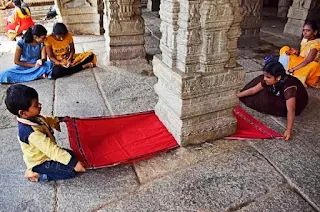Temple Tales:Hidden Mysteries Uncovered
 |
| Hindu urge to start anything and everything with Om Om Namah Shivay |
OUR HINDU TEMPLE
Hindu temple, also Devasthanam, Mandir, Pura, Kovil, Kshethram, the sanctuaries of divine presence, are not merely architectural marvels but embodiment of spiritual devotion and cultural heritage. Temples are not just physical structures; they are living embodiment of faith, tradition, culture and the eternal quest for spiritual enlightenment. There are innumerable temple in and outside India that represent the cultural heritage of Hindu. People visit temple for spiritual worship, cultural and Traditional practices, seeking peace and solace, fulfillment of vows and prayers, community and social gathering, pilgrimage, and overall, people visit temple to nurture their spiritual beliefs, uphold cultural traditions and connect with the divine presence believed to reside within these sacred spaces.
Hindus do not necessarily have to visit temple every day since all Hindu home usually has a small shrine or what we call it as "Pooja Room" for daily prayers. All Hindu temple- no matter where they are : from India's North (Orissa, and Khajuraho), South ( Kanchipuram, Madurai, Tanjore), South West (Hampi, Somnathpur, Pattadakal) to all over India- share a core set of design features, employed to facilitate to believer's interaction with the divine.
There are uncountable and numerous temples all the world, however, there are few mysterious and amazing facts about some temples which you had no idea about and this would blow your mind!
(A) Konark Sun Temple
Konark is a small town in Puri district of Odisha, India. "Konark" comes from the culmination of two words named- Kona+Arka. Kona refers to direction of vision and the word Arka means the Sun God or Surya Bhagwan. The Konark Temple was built by the King Narasimhadeva I of the Ganga Empire on the occasion of winning over the battle with the Muslims.
But there are many stories related to the establishment of Konark Sun Temple. Some believe that this is one of the places where Lord Vishnu placed one of his belongings after successfully defeating the demon Gyasur. He chose the Konark Sun Temple to place his Lotus . Another sect of belief narrates the story of SAMBA, the son of LORD KRISHNA, who suffered with leprosy due to the curse given by his father. To get rid of this curse, Lord Krishna did penance for 12 years at Mitravana near the Chandrabhaga river with the sea at Konark. This pleased the sun God and the as an expression of gratitude, Samba got a temple built which was dedicated to the Sun God.
Coming to the architecture of this living marvel, the whole temple actually symbolizes the chariot of the Surya Dev. However, no ancient scripture accurately mentions about the number of wheels of the chariot of Him, this temple chariot is bound with 24 wheels that represent 24 hours of the day. There are 7 horses pulling the chariot which represent the seven days of the week. Some believe that these 7 horses also represent the 7 colors of the sunlight i.e., VIBGYOR. Others believe that these represent the 7 chakras of the human (Muladhara, Swadhisthana, Manipura, Anahata, Vishuddha, Agna and Sahasrara). Also, the 7 horses of Surya Bhagwan are Gayathri, Bruhathi, Ushnik, Jagathi, Dhrushtup, Anushtup and Bhakthi.
There was also a belief that there was a idol of Surya Dev that was hanging in the air without any support, probably due to Magnetic force and during the war, the idol to shifted to some safe place. Where the idol is and what happened to Him is a part of all the other mysteries associated with this temple. The history is still unclear about the complete details of the Sun Konark Temple.
(B) KAMAKHYA TEMPLE
The Kamakhya Temple,Assam, is dedicated to the mother goddess Kamakhya and is one of the oldest Shakti Peeths. Kamakhya Devi is popularly known as the bleeding goddess. The mythical womb and vagina of Shakti are supposedly installed in the Garvagriha of sanctum of the temple. In the month of June, the Goddess bleeds or menstruates. At this time, the Brahmaputra river near Kamakhya turns red. The temple then remains closed for 3 days and the holy water is distributed among the devotees.
There is no scientific proof that the blood actually turns the river red. Some people say that the priests add vermilion (sindhur) into the water. But symbolically, menstruation is the symbol of a woman's creativity and power to give birth. So, the deity and the temple of Kamakhya celebrate the power within every woman.




.jpg)



Comments
Post a Comment